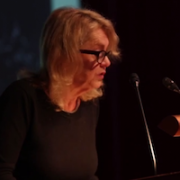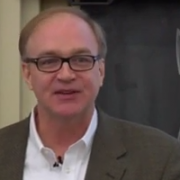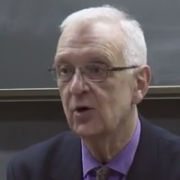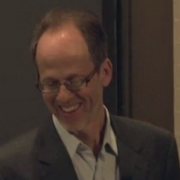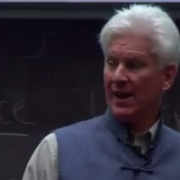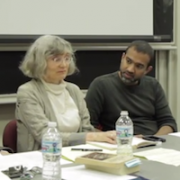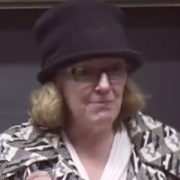The ruin engages a wide spectrum of considerations: cultural, aesthetic, religious, political and psychoanalytic (to name just a few). The ruins of antiquity have, of course, always fascinated scholars and tourists. But the Romantics in particular viewed ancient ruins through the lens of nostalgia, a perspective that is not without political implications. Freud, who grew up reading the Romantics, is himself obsessed with ruins and archeology. His idea of the unconscious is heavily influenced by the ruins of Pompeii and Herculaneum, and by archeological digs. In the twentieth century, the ruins of modern warfare—particularly those of World War Two—serve to change both the status, and the meaning, of ruin-gazing.
Presentations
If you wish, you can download a printable pdf of the program.
Presenter: Elizabeth Asmis
Medical Healing in Ancient Greece and Rome
The ancient Greeks discovered scientific medicine, but how well did they do in healing the sick? This talk will touch on some of the triumphs and failures of ancient medicine. It will also take a look at the Hippocratic oath and its after-life.
Presenter: Michael Bourdaghs
Rethinking Postwar Japanese Culture as Cold War Culture: The Remarkable Life and Times of Jiuji 'George' Kasai, AB'13
One hundred years ago, on June 3, 1913, Jiuji “George” Kasai, AB'13, delivered an address at Mandel Hall on “The Mastery of the Pacific.” The talk, a denunciation of the ongoing anti-Japanese exclusion movement and an emotional call for U.S.-Japanese friendship, was awarded the Julius Rosenwald Prize for Excellence in Oratory. The speech and prize caused a sensation and were widely reported in the press. Kasai went on to a remarkable career. He served as a member of Japan’s parliament and revisited campus in the autumn of 1941 to speak at the University’s fiftieth anniversary ceremonies; he was in the U.S. at the time as a member of the Japanese delegation sent in a last-minute attempt to head off war between the two countries. After the war, he worked closely with American Occupation authorities, becoming a leading figure in anti-communist cultural activities. In 1950 he became the first Japanese citizen to be given an exit visa to travel abroad and again traveled to Hyde Park to speak on campus (he would return once more in 1963). This talk will trace Kasai's remarkable career, exploring what it tells us about U.S.-Japan cultural relations during the Cold War period.
Presenter: Benjamin Callard
The Ethics of Emotions
We judge people for how they feel, and not just for what they do. We sometimes judge them for having the wrong emotional reaction to some event or situation ("How can you be happy at a time like this?"); in other cases we judge them for having the right reaction for too long, or not long enough (King Claudius to Hamlet: "'Tis sweet and commendable in your nature, Hamlet, To give these mourning duties to your father...but to persevere in obstinate condolement is a course of impious stubbornness; 'tis unmanly grief".) This talk will try to answer these questions: do these judgments make any sense? And, if they do, what does that tell us about what feelings are?
Presenter: Thomas Pavel
The History of the Novel
The presentation will examine various kinds of prose narratives—Ancient Greek romances, chivalric stories, pastorals, comic and picaresque novels—showing how their rivalry led to the formation of the modern novel in the eighteenth century.
Presenter: Howard Sandroff
The Obsessive Image
Composer Howard Sandroff discusses the psychological and structural imagery, which drives his unique method of conjuring up and manipulating musical ideas. That same “obsessive image” is manifest and informs the steel scupture he began building in the early 2000’s. These works bear an uncanny aesthetic consistency with his compositions in that they are characterized by objects of extreme economy of material and complexity, which are not born of evolutionary development but by his interest in arresting time and space. The objects, both musical and steel interact with and are woven into with multiple clones and variations of the original object.
The conclusion may be inescapable, that for the last 40 years his musical compositions were actually his obsession to freeze the time and motion of music into the static spatial constructions, which are now his welded steel sculptures.
Using photos and recorded musical examples Sandroff will take you through the “obsessive image”, that dominates both the music and sculpture. Three of his smaller sculptures will adorn the presentation along with examples of recordings and scores.
Presenter: Olga Solovieva
A Portrait of the Artist as President's Wife: Maude Hutchins at the University of Chicago
The artist Maude Phelps McVeigh Hutchins arrived at the University of Chicago in fall 1929 following her husband’s election as the University’s President. She continued her work as a sculptor, painter, poet, and playwright throughout the next twenty years of her career in Chicago, despite the social constraints of her official status. Today, she is remembered almost exclusively for her brilliant erotic novels of the 1950s and 60s, which earned her the reputation of an “American Colette.” The recent NYRB Classics reprint of her 1959 novel Victorine inaugurated a revival of Maude Hutchins’ post-Chicago literary period, while the art of her Chicago time is still immersed in oblivion. Drawing on the materials from the University of Chicago’s Special Collections, this lecture uncovers Maude Hutchins’ forgotten contribution to the climate of intellectual and creative iconoclasm in 1930s and 40s Chicago and reconstructs a piece of the University’s history from an unofficial, intimate, counter point-of-view as reflected in her drawings, sculptures, letters, and poetry.
Presenter: Ulrike Stark
The Coming of Print in Colonial India: Texts, Technologies, and the Virtue of Perseverance
The Industrial Revolution and the global transfer of new printing technologies in the late 18th and early 19th centuries led to a boom in printing in colonial India. Probably more books were lithographed in the subcontinent than in Europe at the time. This talk will explore the early history of print in north India from the perspective of materiality and technology. We will discuss material conditions, the economics of book production, and the many difficulties faced by the pioneering generation of Indian printer-publishers in a vibrant, challenging, and frequently unprofitable business.
Presenter: William Tait
Idealization vs. Abstraction: Plato vs. Aristotle on Scientific Explanation
Plato’s conception of scientific explanation is most often viewed through the lens of Aristotle’s writings. On this view, Plato’s conception centers on what has been called his ‘theory of ideas’, a grand but somewhat mystical and toothless conception, which Aristotle rightly displaced with his doctrine that knowledge of the general arises by abstraction from perception of the particulars. I will suggest that Plato’s idea was neither quite so grand, nor at all mystical, and certainly not toothless. It was the idea that exact science proceeds by idealizing the phenomena it is to investigate. Idealization introduces structure that is not part of the phenomena and so truth concerning it is not to be found by ‘abstraction’ from the phenomena, but rather by focusing on the ideal structure itself. (This last bit is the point of the Divided Line simile!) History has been on Plato’s side.
Presenter: Arata Takeda
Suicide Attack: A Literary Approach
The phenomenon of suicide attack, as most prominently observed in the strategy of contemporary terrorist organizations, has been investigated by a wide variety of academic disciplines ranging from anthropology and psychology to religious studies and political science. Whereas it appears to be tempting to relate it to culture or religion, scholars have described and explained the phenomenon in many different terms and ways. What is noticeable about the research undertaken so far, however, is that its focus has by and large remained on real and hard facts. As a matter of fact, there are good reasons to include products of imagination in considering the phenomenon, for real action is more often than not preceded by imagination. This talk will explore what literature and imagination have to say about the phenomenon of suicide attack by rendering visible the ways in which the study of fiction can contribute to the understanding of reality.
Presenter: Christina von Nolcken
The Vikings and a Turbulent Anglo-Scandinavian World
On August 14, 2007, Denmark apologized for her part in the ninth-century invasions of Ireland. As far as we know, she has not yet apologized to England. This talk will track the Vikings' impact on medieval England, an impact whose effects are still evident today. We will meet, among others, Ragnar Hairy Breeches, who ended his days in a snake pit; his son, Ivar the Boneless, reputedly nine feet tall; Eric Bloodaxe, the last Viking king of York; Olaf Tryggvason, who rammed Christianity down unwilling Scandinavian throats; Svein Forkbeard, who absorbed England into a Denmark-centered empire; and the last of the great Vikings, Harald Hardrada.
Presenter: Rebecca West
The Persistent Puppet: Pinocchio's Afterlife in Literature, Cinema, and Popular Culture
Carlo Lorenzini, pen name Collodi, never could have imagined the longevity of his mischievous wooden puppet, Pinocchio. Published serially in a magazine for children, the nineteenth-century Tuscan tale was and remains one of the world's most enduring and beloved stories, having been translated into dozens of languages, made into numerous live and animated films, served as inspiration to many "serious" modern writers, and provided an immediately recognizable image of mendacity in the form of a nose with a mind of its own! To explore the afterlife of Collodi's tale is to enter into a world of proliferating Pinocchios whose persistence stimulates us to ask why a didactic story written for school children at the dawn of the new Italian nation should go on resonating with such relevance to our own lives over a century later. What gives some literary characters such long and rich afterlives while others fade into oblivion? How do some tales travel so well beyond their specific national and linguistic origins? Why does the scamp Pinocchio still capture hearts and minds from Florence to Chicago, from young to old?
Presenter: Leila Wilson
A Reading from The Hundred Grasses
Creative Writing faculty member Leila Wilson is a poet and graduate of the MAPH, and the former poetry editor of the Chicago Review. She will be reading from her book The Hundred Grasses (Milkweed Editions, 2013). Her poems have appeared in A Public Space, Denver Quarterly, Poetry, The Canary, and elsewhere. She is the recipient of a Friends of Literature Prize from the Poetry Foundation and an Academy of American Poets College Prize. She received an MFA from Indiana University.
Presenter: Niall Atkinson
Getting Lost in the Italian Renaissance: The Geography of Urban Disorientation
A merchant in fourteenth-century Naples has to relieve himself at night in an alley, a woodcarver in fifteenth-century Florence decides to ignore a dinner invitation, the poet Petrarch finally arrives in Rome for the first time, and a Roman servant returning to his native city can’t remember where his mistress’ palace used to be. What do all these characters have in common? They are all hopelessly lost. Pre-modern city-dwellers in Italy constructed their sense of self by linking their fates to the structures and people with which they lived. But what if those same city-dwellers found themselves in unknown territory or suddenly found that the streets they thought they knew had become a series of alien encounters? This presentation explores the nature of the relationship between familiar and unfamiliar urban spaces in the Italian Renaissance. Contrary to prevailing assumptions about the emergence of the modern individual as a self-made entity, these episodes reveal just how unstable one’s identity actually was and just how difficult it was to actually “know thyself.” Such knowledge was always a negotiation between the self, others, the past, and the built environment.
Presenter: Diane Brentari
Differences in Prosody between Black and White Varieties of American Sign Language
Just as there are dialect differences between Standard American English and African American Vernacular English, there are differences in the standard variety of American Sign Language (ASL) and the one used by the African American Deaf community. In this study, the patterns of movement and pausing during third person narratives reveal a difference in the storytelling register of these two varieties of ASL.
Presenter: Hillary Chute
I Saw It: Graphic Narrative and Witnessing War
This talk focuses on the form of comics and what it means to bear witness to war through this handmade word-and-image medium. Inspired by the traumas of WWII and also the war in Vietnam, the form of comics emerged across the globe as a documentary medium in the 1970s. This presentation charts this development through attention to field-establishing work by Japanese cartoonist Keiji Nakazawa, a Hiroshima survivor, and American cartoonist Art Spiegelman, whose parents survived Poland’s death camps. It considers contemporary modes of visual witnessing and their relation to many long histories and traditions of visual witness, looking to key antecedents and also to new genres like Joe Sacco’s “comics journalism.”
Presenter: Fred Donner
An Enigmatic Papyrus Document from Early Islam
The traditional vision of the Islam's origins in the seventh century has been challenged fundamentally in recent years because, for the most part, that vision was based on Muslim sources of later date. Actual documents dating from the origins period are extremely rare. The talk will present an Arabic papyrus document that appears to date from the earliest phase of the Islamic community, and attempt to explain what its intriguing and sometimes puzzling features imply for our understanding of Islam's beginnings.
Presenter: Sascha Ebeling
What Is World Literature?
For about a decade, scholars in the U.S. and elsewhere have been debating the issue of "world literature" with renewed vigor, often beginning with a reconsideration of Goethe's famous idea of a Weltliteratur. Building on this recent debate, this talk will engage two seemingly simple questions: What is world literature? And: Why should we care?
Presenter: Judy Hoffman, Tom Gunning
Examining Study and Practice with the Moving Image
Join two faculty members from the Department of Cinema and Media Studies as they present a shot analysis from the work of director Fritz Lang and screen a student produced piece. You will gain valuable insight regarding the interplay of theory and practice in the construction of film. Judy Hoffman, Professor of Practice in Cinema and Media Studies, and Tom Gunning, the Edwin A. and Betty L. Bergman Distinguished Service Professor in Art History and Cinema and Media Studies, will provide insights into how each scene was produced as well as an historical context and a critical perspective on each scene.
Presenter: Gabriel Richardson Lear
Plato on Philosophical Wonder
Socrates said that “philosophy begins in wonder.” What is this experience of wonder and why is it so important for philosophy or, more generally, the love of wisdom? Starting with Aristotle, many philosophers have thought of philosophical wonder as a sort of puzzlement that prompts us to seek out new, better understandings of ourselves and our world. From this point of view, although philosophy begins in wonder, it seeks to overcome it. Understanding dispels puzzlement and with it our wonder. Plato had a quite different view. For him, the love of wisdom begins in wonder and is sustained by it. We will explore why he thought this and how it might affect our understanding of humanistic education and inquiry.
Presenter: Marko Malink
Deductive Inference and the History of Logic: Two Perspectives
Aristotle (384-322 BC) was the founder of the discipline of logic. Gottlob Frege (1848-1925) was one of the founders of modern mathematical logic. Aristotle's "Prior Analytics" and Frege's "Concept-Script" are among the most influential texts in the history of logic. While they differ in many respects, there are some significant similarities in their treatment of deductive inference. Both of them take a distinctively formal approach to deductive inference. This presentation will explore these similarities, aiming to determine the sense in which both logical systems can be said to be "formal". To this end, we will look at Aristotle's informal account of deduction in the "Topics", and at how it differs from the formal, syllogistic account provided in the "Prior Analytics".
Presenter: William Nickell
Olympic Minds, Bodies, and Souls: Sochi in its Soviet Past
The Russian government has made a high-stakes gamble that Sochi, more familiar as a sub-tropical resort, can host the 2014 Winter Olympics. But this new Olympic city is being built over the top of another, one that expressed even greater imagination and ambition. In the Soviet period, Sochi was a socialist resort where workers could temporarily experience the idyllic life that was promised in the communist future. They were also trained to live that life through the careful administration of sleep; diet; exercise; sun, sea, and wind bathing; cultural programming; social interaction; and a surprising array of medical therapies. We will learn how “recreation” was taken literally at the Soviet resort, as a means to produce a new, better human being. The talk will include a demonstration of Franklinization, which revitalized the body by applying a shower of electrical current.
Presenter: Geof Oppenheimer, Jessica Stockholder, Laura Letinsky, William Pope.L
Tour Midway Studios at the Invitation of Department of Visual Arts (DoVA) Faculty
Faculty members Jessica Stockholder, Laura Letinsky, William Pope.L, and Geoff Oppenheimer will open their doors and share some of their working process with you. Join in a conversation with the artists about their work.
Presenter: Haun Saussy
The Curious History of the Concept of Oral Literature
"Oral literature" sounds like a paradox, since "literature" involves (etymologically and in principle) "letters." Although "literature without letters" has no doubt existed since the beginnings of human language, the concepts used to describe it are of much more recent vintage. Two periods saw the emergence of such concepts: the seventeenth and early twentieth centuries. Detaching "literature" from letters proves no easy task, as this historical investigation shows.
Presenter: Jennifer Scappettone, John Wilkinson, Peter O'Leary, Vu Tran
How Writers Read
Faculty members from University of Chicago's Creative Writing program choose a piece of writing that has been important to them, read an excerpt, and talk about it from a writer's perspective. How does this differ from a scholar's perspective, or that of a recreational reader? Listen to Jennifer Scappettone, poet, scholar and award-winning translator; Vu Tran, novelist and short story writer; and Peter O'Leary, poet and scholar, discuss this question and whatever arises in a presentation chaired by John Wilkinson, chair of the Committee on Creative Writing.
Presenter: Bart Schultz
Art Means Business
Presenter: Edward L. Shaughnessy
Signs of Writing in China
The Chinese writing system is usually regarded as one of four independently created writing systems in the world. In this presentation I will explore the earliest material evidence for writing in China, will describe the several principles used to create Chinese characters, and will consider the possible significance that the nature of the writing system may have had for the rise of literature in China.
Presenter: Staff
Tour of Suicide Narcissus: At the Renaissance Society
Featuring eight artists, Suicide Narcissus is a group exhibition meant to serve as a contemporary vanitas. Maybe the Mayans weren't referring to an event but a mindset. Although the world did not end in 2012, climate change has forced us to think about our fate as a species, to confront the thought of our extinction wondering if we are an exception. Clearly, the grand evolutionary scheme of things tells us no. Human history relative to natural history amounts to a mere speck in time. The earth was here long before us, and it will be here long after us. Over the 3.5 billion years of life on earth, countless species have come and gone. While this is a humbling thought, as the planet's dominant species, we are less defined by our humility and more by our chauvinism. The will to survive has become the right to survive, a right whose abuse has made startlingly clear the fragile parameters governing terrestrial life. Our ecological crisis taints all facets of our relationship to nature such that culture and our quest for knowledge can only be juxtaposed against reflections on folly, catastrophe and death.
Tour of Wings, Speed, and Cosmic Dominion in Renaissance Italy: At the Smart Museum
Wings are prevalent in a wide range of Renaissance representations, from figures (angels, winged cherubs, and mythological gods) to animals (eagles, griffins, and winged horses). The multiple iconographies of wings during this period drew on allegorical, cosmological, and religious symbols inherited from both Christian and ancient Near Eastern mythologies.
Drawing on the Smart Museum’s permanent collection, with selected loans from the University of Chicago’s Library and the Oriental Institute, this intimate exhibition examines the Renaissance fascination with wings as symbols of speed and power through the influential histories of flight derived from the bird cult of Horus in ancient Egypt to the circulation of winged creatures in prints by Albrecht Dürer and others.
Presenter: Robert Whalen
Music, Heuristics, and Interpretation: A Conductor's Search for Musical Meaning
Orchestral conductors are responsible for a vast amount of musical information. A conductor must discern and understand the relationships between hundreds of thousands of notes, dynamics, articulations, and other instructions from the composer. From this information, a conductor must then find and internalize a logic from these data that can communicate on a sensory, psychological, and emotional level. In my presentation, I will discuss the process I created for internalizing and interpreting music, which shares many principals of heuristics used in data-intensive computing. I will illustrate these connections as I lead the audience through their own process of interpretive discovery using examples from Beethoven's Coriolan Overture, George Benjamin's At First Light, University Professor Augusta Read Thomas's Twilight Butterfly, Schoenberg's Chamber Symphony no. 1, op. 9, and Wagner's Siegfried Idyll.
Presenter: Orit Bashkin
Transit Camps or Refugee Camps? Managing the Migration of Iraqi Jews in 1950s Israel
My talk studies the ongoing waves of protests, demonstrations, and strikes, organized in Israel by newcomers from Iraq in the early 1950s. During the years 1950–1951 over 120,000 Iraqi Jews arrived in Israel. Many of them had come to Israel with virtually no money, because of legislation passed in 1951 in Iraq that froze most of their assets. Holocaust survivors, Jews from Arab states, and other migrants all flocked to the young Israeli state, which lacked sufficient resources to absorb them. Consequently, transit camps (Hebrew: Ma‘abara, plural: Ma‘abarot) were established by the state all over the country; most Iraqi Jews found themselves in these camps, alongside migrants from Poland, Iran, Romania, Yemen, and other countries. In 1951, 100 camps held 212,000 people, 80,000 of whom were Iraqis. There were clashes and demonstrations in these camps arising from the migrants’ demands to be granted basic citizenship rights, such as labor and housing, and in protest of the state’s indifference to their sufferings and their insufferable living conditions. My talk analyzes the ways in which these migrants interacted with the Israeli state, that is, the ways in which the Israeli state attempted to help the migrants, but also curtail their protests and their politicization, and the activities of Iraqi Jews within these years.
Presenter: Catherine Baumann
The Chicago Language Center: Goodbye, Language Labs!
Join us for a presentation about the field of language pedagogy and tour the Chicago Language Center. Open since 2007, the design of the CLC reflects the changing world of second language learning and teaching in the advent of multi-media, web-based materials, and access to speakers and learners all over the world.
Presenter: Steven Collins
Buddha, the Prequel: Vessantara Gives Away His Children and His Wife
In the penultimate human life of the series which ended with our Buddha, Siddhattha Gotama, Prince Vessantara gives away the state elephant; he is banished from the city and goes to live in a forest with his wife and children. He gives the children away as servants to a vile old beggar, then his wife (to the King of the Gods in disguise). This is often presented as his fulfilling the Perfection of Generosity. What sense can we make of this?
Presenter: Martha Feldman
How to Hear an Unheard Voice: Explorations in Improbable Listening
In the absence of sound, interior listening mediated by imagination, intellect, memory, wonder, desire, and virtually involuntary physical impulses, helps us imagine voices we cannot hear. This talk wonders how these can be deployed in conjunction with hard acoustic and anecdotal evidence in an effort to recover something of the lost voices of castrated male singers, who from the sixteenth through nineteenth centuries laid the foundations of Western art singing. How might an acoustic phenomenon made up of exceptional timbre, emission, and resonance be rediscovered in the mind’s ear? Two bodies of evidence are critical. The first is the early recorded singing of the only castrato who made recordings (Alessandro Moreschi, 1902 and 1904) and of other early recording artists. The second is made up of eighteenth- and nineteenth-century writings; some pedagogical, some critical, autobiographical, or anecdotal. Castrato voices emerge as having had a unique timbre and registration, with (among other factors) greater access to “chest-dominant” sound than in “normal” voices and greater fluidity in their head-dominant sound, and a special predisposition to flexibility throughout both registral areas. Hearing the voices of castrati in the mind’s ear, as acoustic and not just stylistic phenomena, offers a way into their fascinating performances.
Presenter: Frances Ferguson
Play into Game: Fitting Education to the Masses (around 1800)
In the late eighteenth century in Britain, a number of social and economic conditions converged to make it seem desirable for education to be more widely available than it had been before. The population had increasingly concentrated in urban centers to find employment as small farms had difficulty surviving. When the people whom one educational writer referred to as the "industrious poor" worked in urban manufacturing, they were often obliged to leave their children unattended (and thus to make them "latch-key children"). At the very end of the eighteenth century and the beginning of the nineteenth, educational writers developed schemes for providing education for such children (in London, in Madras, and then, most prominently, in the United States). These writers hoped to reduce the cost of education so that it could be extended to more students, but in the process of economizing, they changed fundamental elements of previous understandings of education – particularly by moving away from an emphasis on individual teachers and individual students to an emphasis on classes of students. This talk will take up the importance of these developments and about the debates over the proper relation between schools and the Church of England that delayed universal elementary education in England until 1870. In particular, this talk will address the importance of a move away from rote memorization to the development of an appreciation for facts.
Presenter: David Finkelstein
Wonder, Magic, and Skepticism
On the one hand, in Plato’s Theaetetus, Socrates says (famously), “The sense of wonder is the mark of the philosopher. Philosophy indeed has no other origin.” On the other hand, when magicians write about their aesthetic aims (which they do), they almost always describe themselves as trying to instill wonder in their spectators. In my presentation, I’ll be discussing the character of wonder and the peculiar aesthetics of magical performance. I’ll suggest that it is worthwhile to compare philosophical arguments (especially arguments for one or another sort of radical skepticism) with magic tricks and that by doing so, we may come to somewhat better understand what is both appealing and frustrating about the study of philosophy.
Presenter: Melissa Gilliam, Patrick Jagoda
Gaming the Humanities: Transmedia Play and Connected Learning
Games and gamification are a major issue of the still-emerging digital humanities. Computer, video, mobile, and alternate reality games — through their mechanics, navigable worlds, and multimedia interactions — call for new literacies that exceed traditional reading and writing skills. Digital games demand new ways of perceiving and working. They seem to matter to the unfolding of the twenty-first century everyday, even if we do not yet always recognize precisely how they matter. This talk introduces an experimental initiative, the Game Changer Chicago Design Lab, in which faculty, university students, and high school youth from the community collaborate to create digital stories and games in order to explore issues related to emotional health, social justice, and digital literacies. Throughout the humanities, the Lab promotes the study of electronic literature, new media art, popular cultural forms, digital media and learning, and the rapidly expanding field of videogame studies. Patrick Jagoda (Assistant Professor of English), the co-founder of the Lab with Melissa Gilliam (Professor of Obstetrics, Gynecology, and Pediatrics), will introduce the Lab and speak about a transdisciplinary and narrative-based alternate reality game, The Source, and its intervention in the contemporary situation of the humanities.
Presenter: Amber Ginsburg
The Archive and the Repertoire: Two Bodies of Knowledge in my Sculpture
During this slide lecture I will present a sampling of my research-based installations, discuss my research methodology and examine the importance of collaboration in my practice.
Through multi-media installations that incorporate objects and actions, I delve into interpretation of histories. My work functions as a stage for two bodies of knowledge: the archive, which lives in books, images and objects and the repertoire, found in the long history of movement passed from person to person. Each project pulls a single object or action of a narrative and then stages a re-enacts or reimagines the historical practices of that object.
The work depends on collaboration with other artists and experts—scientists, historians, first-person witnesses. I take on the roles of artist, social scientist, and curator while working with people who daily perform the tasks of a story—archivists, farmers, and builders. During an exhibition, the collaboration extends to the audience and in a sense, the gallery. Influenced by my background in ceramics, I carry labor and craft traditions into my research-based installations. The ceramicist's practice of monitoring the drying process becomes a framework for performance in my projects with daily interactions or episodic actions in the gallery. I continually re-activate and reshape the work by making transparent a narrative of production through the accumulation of labor within the gallery. With an eye towards extending knowledge, the audience often participates in the production the work.
Presenter: Berthold Hoeckner
Listening to Film
This presentation will explore several striking examples of film sound and film music. I will demonstrate how filmmakers sometimes deploy the soundtrack in unusual ways to guide viewers in the perception and understanding of what happens on screen.
Presenter: Dorothea Hoffman
Moving Through Space and (Not?) Time: North Australian Dreamtime Narratives
This talk takes up dreamtime narratives with original research analysis of narrative structure in three North Australian languages; Jaminjung, MalakMalak, and Kriol. Traditional dreamtime stories are inherently bound to the place and landscape they are located in, and, by default, narrated in-situ. Temporal order of events within the narrative flow may be overridden by spatial ordering, thus placing emphasis on a change of location rather than logical time sequence of events. Various story-telling versions of the same narratives reveal that temporal order of events is flexible and that the structure may be mapped onto space in a meaningful fashion. It is observed for MalakMalak that dreamtime narratives often focus on the narrative significance of place, re-telling the land rather than the story alone by simultaneously telling multiple stories that take place in the same location at the same time. Additionally, restriction in movement ultimately leads to stagnation within the plot of a story, making 'motion' a key structural and contextual element for most narratives analyzed in this study. In general, the established significance of ‘place’ is directly linked to the owner’s identity. This relationship may be found in narratives of all three languages, thus indicating a continuing cultural trait irrespective of language shift.
Presenter: W.J.T. Mitchell
Seeing Madness: Mental Illness, Media, and Visual Culture
"Seeing Madness" surveys the representation of mental illness in audio-visual media, from theater to opera to photography and cinema. The talk will address several questions. Why do people want to "see madness" in the first place? What is so fascinating about it? To what extent does mental illness defy visual representation? What is the relation between individual and collective forms of madness (e.g. mass hysteria and paranoia), and how are these reflected in different forms of representation?
Presenter: Gina Olson, Linda Zerilli, Monica Mercado
A "Desire for History": Building Queer Archives at the University of Chicago
How does queer studies engage with the archive? Since 2007, faculty and students affiliated with the University of Chicago’s Center for the Study of Gender and Sexuality have worked to build archival collections documenting the experiences of women and LGBTQ individuals and communities at the University of Chicago. This lecture will give a brief history of the project’s origins in feminist and women’s history, and ask what it means to once-marginalized communities to have a place in the University archives. It will offer a first look at many of the items and oral history interviews that have been collected documenting LGBTQ life on campus from the era of Gay Lib to the present day. The presentation will be followed by a reception celebrating the Center’s newly renovated building on University Avenue.
Presenter: Eric Slauter
On Nostalgia and the Chromocord: A Panel on the Arts|Science Initiative
The Arts|Science Initiative encourages independent cross-disciplinary research between students in the arts and the sciences. Graduate students from areas such as art history, English, music, cinema and media studies, theater and performance, creative writing, or visual arts are encouraged to pair up with graduate students from astronomy and astrophysics, biological sciences, chemistry, computer science, geophysical sciences, math, physics, or statistics areas for joint research projects. Two of the projects from 2012-2013, "The Chromocord," a collaboration between Francisco Castillo Trigueros (Music) and Josiah Zayner (Biochemistry and Molecular Biology), and "Nostalgia: A Digital History," a collaboration Rebekah Baglini (Linguistics) and Jonathan Schroeder (English) will be featured at a panel moderated by Eric Slauter.
Presenter: Staff
Tour of Suicide Narcissus: At the Renaissance Society
Featuring eight artists, Suicide Narcissus is a group exhibition meant to serve as a contemporary vanitas. Maybe the Mayans weren't referring to an event but a mindset. Although the world did not end in 2012, climate change has forced us to think about our fate as a species, to confront the thought of our extinction wondering if we are an exception. Clearly, the grand evolutionary scheme of things tells us no. Human history relative to natural history amounts to a mere speck in time. The earth was here long before us, and it will be here long after us. Over the 3.5 billion years of life on earth, countless species have come and gone. While this is a humbling thought, as the planet's dominant species, we are less defined by our humility and more by our chauvinism. The will to survive has become the right to survive, a right whose abuse has made startlingly clear the fragile parameters governing terrestrial life. Our ecological crisis taints all facets of our relationship to nature such that culture and our quest for knowledge can only be juxtaposed against reflections on folly, catastrophe and death.
Tour of Wings, Speed, and Cosmic Dominion in Renaissance Italy: At the Smart Museum
Presenter: Richard Strier, Rosanna Warren, Sarah Nooter, Srikanth Reddy
Poetics Across the Disciplines: A Panel Discussion of George Herbert's "Death"
In this session, a panel of University of Chicago faculty members from various fields—including Classics, Romance Languages and Literatures, English, and Creative Writing—will discuss George Herbert's poem "Death." In conversation with one another and the audience, this panel will illustrate how interdisciplinary perspectives in the humanities may shed light on a masterpiece of lyric poetry.
Presenter: Candace Vogler
Good and Bad in Human Action
Aristotle held that all action aims at the good and Aquinas held that a primary orientation to the good cannot be obliterated from human hearts or minds. For anyone who pays any attention to current events or to accounts of hideous things that people have done in the past, this thought looks very odd. Why would anyone think that people in general seek to pursue good and avoid bad? Where can we even look to find an orientation to good in human beings generally? In this talk, I will draw from a number of sources in the course of beginning to answer these questions.
Presenter: Patrick Jagoda
Game Changer Chicago: Card, Board, and Computer Games for Change
The Game Changer Chicago Design Lab is an initiative in which youth collaborate with faculty and university students to create digital stories and games in order to explore various health-related issues. The GCC Design Lab workshops help youth gain skills in media literacy, critical inquiry, storytelling techniques, and game design. The Lab was started by Melissa Gilliam and Patrick Jagoda at the University of Chicago. Jagoda and Gilliam, alongside Lab game designers, will offer hands-on demos of a few of the games created through the project.
Presenter: Staff
Tour of the Reva and David Logan Center for the Arts - 12:30
Students and staff will lead guided tours of the Reva and David Logan Center for the Arts, offering the opportunity to experience firsthand the groundbreaking work of architects Tod Williams and Billie Tsien. Building highlights include the 474-seat Performance Hall, DelGiorno Deck and Mezzanine, Terrace Seminar Room, Gidwitz Lobby, a gallery space, fourteen arts classrooms, a film screening room, and over 90 individual arts studios, rehearsal rooms, and digital media labs.
Tour of the Reva and David Logan Center for the Arts - 1:30
Students and staff will lead guided tours of the Reva and David Logan Center for the Arts, offering the opportunity to experience firsthand the groundbreaking work of architects Tod Williams and Billie Tsien. Building highlights include the 474-seat Performance Hall, DelGiorno Deck and Mezzanine, Terrace Seminar Room, Gidwitz Lobby, a gallery space, fourteen arts classrooms, a film screening room, and over 90 individual arts studios, rehearsal rooms, and digital media labs.
